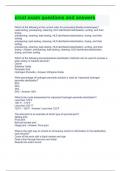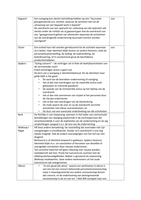SUMMARY – OM Foundations
Table of contents
Lectures 2
Tutorials 9
Required Videos 14
Required Papers 15
Optional Papers 27
LECTURES
,Lecture 2
Stakeholder = a person, group or organization with a vested interest, or stake,
in the decision-making and activities of a business, organization or project
An operations perspective on circularity:
1. Access (product take-back management)
-> do I have access to used products/materials/components?
2. Process (reprocessing operations management)
-> can I recover at a reasonable price?
3. Value (reprocessed products market development)
-> is there a market for the reprocessed items/materials?
Circularity strategies:
1. Retain product ownership (RPO)
2. Design for repair, refurbishment, recycling (DFR)
3. Product life extension (PLO)
How to analyse and optimize a process:
Step 1: Draw a process flow diagram
Step 2: Find the capacity of each resource in the same unit
Capacity = the number of unit of flow that a given resource can process per unit
of time
Example: if it takes a worker 6 minutes to process an item, the capacity is 1/6
units per minute or 10 units per hour
Step 3: Calculate the utilization of each resource
Utilization = input rate to the resource / capacity of the resource
-> if the input is higher than the capacity, the output is equal to the capacity of
the resource
Step 4: Find the bottleneck
This is the resource with the highest utilization
Step 5: Utilize the bottleneck at 100%
Start with the bottleneck and make sure it uses up 100% of its capacity, then
adjust the other resources accordingly to optimize your process
2
, System capacity = system output per unit of time when the bottleneck is 100%
utilized
Guest Lecture: Sustainability in Supply Chain & Operations
Double materiality: a guiding principle for sustainability reporting
1. Impact materiality -> the impact of an entity’s activities on the world
2. Financial materiality -> the impact of sustainability topics on the entity
CARE Framework:
Lecture 4
The Kraljic Matrix
= classification of purchases to guide purchasing decisions
-> managers should recognize the weaknesses of their organization and
formulate strategies for guarding against supplies disruption
Axes of the matrix:
1. Strategic importance / Financial impact (contribution to business
performance)
2. Supply risk / Supply market difficulty
3
Table of contents
Lectures 2
Tutorials 9
Required Videos 14
Required Papers 15
Optional Papers 27
LECTURES
,Lecture 2
Stakeholder = a person, group or organization with a vested interest, or stake,
in the decision-making and activities of a business, organization or project
An operations perspective on circularity:
1. Access (product take-back management)
-> do I have access to used products/materials/components?
2. Process (reprocessing operations management)
-> can I recover at a reasonable price?
3. Value (reprocessed products market development)
-> is there a market for the reprocessed items/materials?
Circularity strategies:
1. Retain product ownership (RPO)
2. Design for repair, refurbishment, recycling (DFR)
3. Product life extension (PLO)
How to analyse and optimize a process:
Step 1: Draw a process flow diagram
Step 2: Find the capacity of each resource in the same unit
Capacity = the number of unit of flow that a given resource can process per unit
of time
Example: if it takes a worker 6 minutes to process an item, the capacity is 1/6
units per minute or 10 units per hour
Step 3: Calculate the utilization of each resource
Utilization = input rate to the resource / capacity of the resource
-> if the input is higher than the capacity, the output is equal to the capacity of
the resource
Step 4: Find the bottleneck
This is the resource with the highest utilization
Step 5: Utilize the bottleneck at 100%
Start with the bottleneck and make sure it uses up 100% of its capacity, then
adjust the other resources accordingly to optimize your process
2
, System capacity = system output per unit of time when the bottleneck is 100%
utilized
Guest Lecture: Sustainability in Supply Chain & Operations
Double materiality: a guiding principle for sustainability reporting
1. Impact materiality -> the impact of an entity’s activities on the world
2. Financial materiality -> the impact of sustainability topics on the entity
CARE Framework:
Lecture 4
The Kraljic Matrix
= classification of purchases to guide purchasing decisions
-> managers should recognize the weaknesses of their organization and
formulate strategies for guarding against supplies disruption
Axes of the matrix:
1. Strategic importance / Financial impact (contribution to business
performance)
2. Supply risk / Supply market difficulty
3











